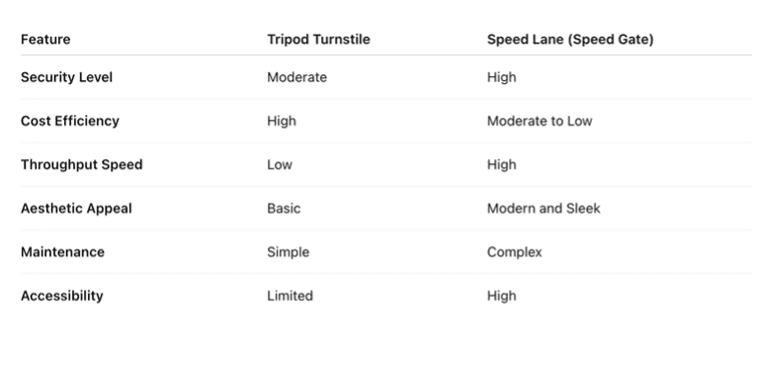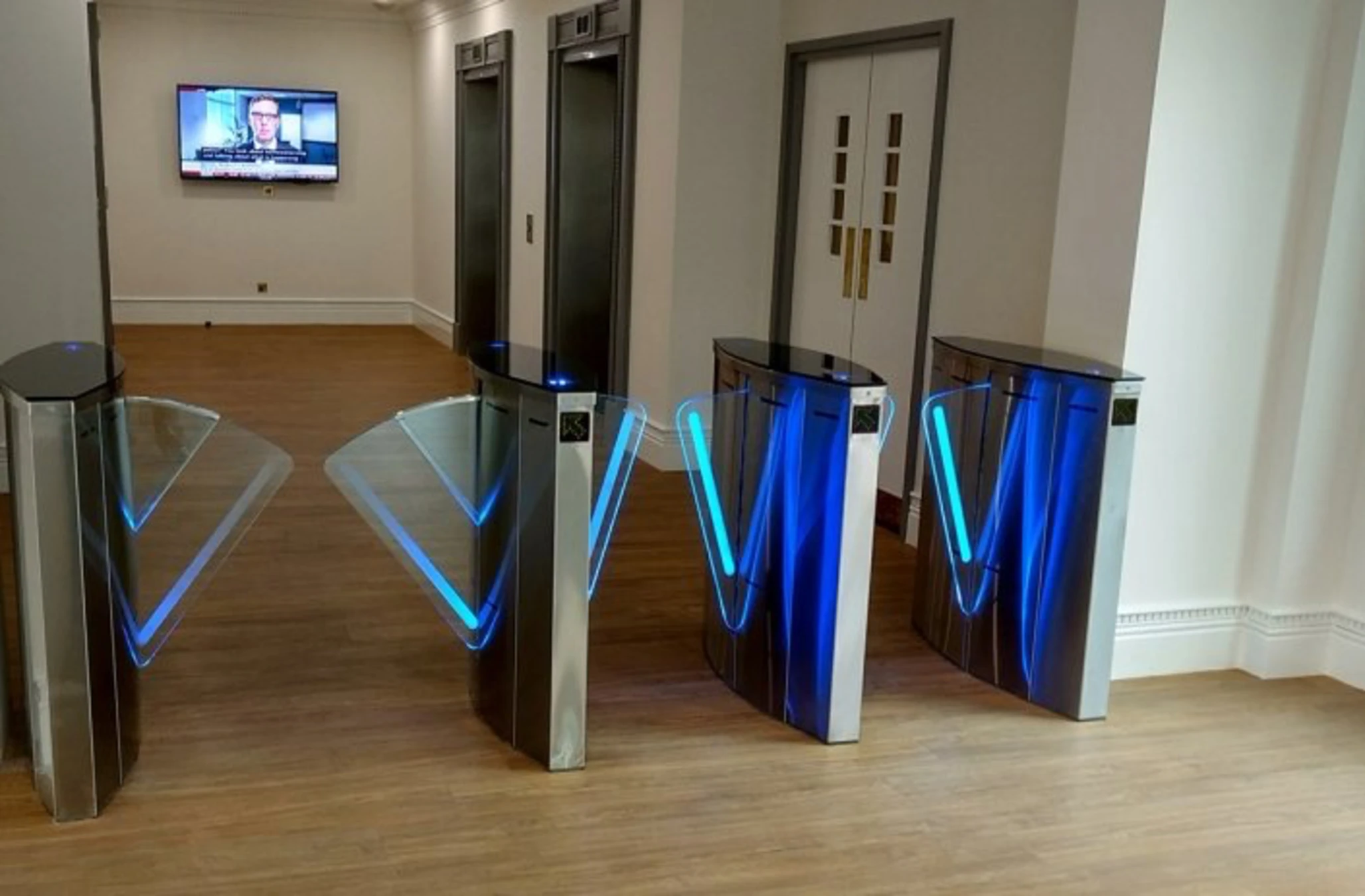A site’s entrance can serve multiple functions. Security, traffic flow, energy efficiency… there’s many things to consider when choosing an access control solution.
From corporate offices to airports, stadiums to leisure centres, many business premises requires a balance of security, efficiency, and aesthetics. Two popular options for these premises are the tripod turnstile and the speed lane (also known as a speed gate).
In this article, we delve into their differences to assist you in making an informed decision for which entry solution is right for you. So, what’s the difference between a tripod turnstile and a speed lane?
What is a tripod turnstile?
A tripod turnstile is a mechanical access control device featuring three rotating arms. These arms allow one person to pass at a time, offering a great solution for controlled entry and managing heavy traffic flow.
How tripod turnstiles work
Tripod turnstiles operate by rotating their arms when activated either by pushing with automatic authorisation, or by a valid credential, such as a key card or ticket (often called Electromechanical turnstiles). This mechanism makes sure that only authorised individuals gain entry – keeping your site secure and adding a layer of security at the entrance.
What are the common uses of tripod turnstiles
Tripod turnstiles are commonly found in:
- Public transportation stations
- Stadiums and arenas
- Industrial facilities
- Educational institutions
What are the advantages of tripod turnstiles
Tripod turnstiles are a cost-effective option and generally more affordable than advanced systems. They’re also durable, built to withstand high-traffic environments. You can also have some choice over style and customisation, for example, choosing glass panels with our glass-pass turnstile.
Another plus for these access control solutions for commercial sites is that they’re easy to maintain, with simple maintenance requirements such as mechanical parts that are easy to service.
What are the limitations of tripod turnstiles?
Whilst a very effective choice for commercial sites that require strong security-led entry solutions, it’s worth bearing in mind some of the potential drawbacks to turnstiles. Although, the benefits far outweigh the potential issues for most businesses.
- Limited throughput: slower processing of individuals.
- Aesthetic considerations: may not align with modern architectural designs.
- Accessibility: less accommodating for individuals with disabilities.
What is a speed lane (speed gate)?
A speed lane, or speed gate, is an advanced access control system that uses sensors and barriers to allow rapid entry for authorised users. So, how do they work? Well, speed lanes utilise infrared sensors and motorised barriers that retract quickly upon credential verification. This allows for an easy and quick passage for visitors.
Speed lane vs. speed gate: are they the same?
While often used interchangeably, “speed lane” typically refers to the pathway, whereas “speed gate” denotes the entire system, including sensors and barriers, that said, these terms are often used for one another, and serve similar if not the same functions.
There’s a speed lane speed gate for every site, whether you have a small space and need a compact speed gate, or even choose a glass speed gate for a more professional brand image, there’s something for every business. You can view our range of speed lanes here.
Speed lanes are a popular option for many industries, including corporate headquarters, airports, government buildings and high-end residential complexes.
What are the benefits of using speed gates?
- High throughput: processes individuals quickly.
- Enhanced security: advanced sensors detect unauthorised access attempts.
- Modern aesthetics: sleek designs complement contemporary architecture.
What are the downsides of speed gates?
- Higher cost: more expensive than traditional turnstiles.
- Complex maintenance: requires specialised servicing.
- Sensitivity: may be affected by environmental factors.
Tripod turnstile vs. speed Lane: a side-by-side comparison

Which access control system is right for you?
When choosing between a tripod turnstile and a speed gate, consider the following factors:
- Budget: tripod turnstiles are more cost-effective.
- Traffic volume: speed lanes handle higher throughput efficiently.
- Security needs: speed gates offer advanced security features.
- Design preferences: speed lanes provide a modern aesthetic.
- Accessibility requirements: speed gates are more accommodating.
For high-security areas with significant foot traffic, a commercial speed gate is an excellent choice. If you’re a business looking to find a secure entry solution for budget-conscious projects that needs to cater to moderate traffic, a tripod turnstile offers the perfect solution.
Speak to our specialists about your tripod, turnstile or speed lane options
Both tripod turnstiles and speed lanes serve as fantastic access control solutions for businesses from a range of industries. Each option has it’s distinct advantages, so we advise speaking to a specialist about your site to talk through the right entry solution for you now, and as you grow. Your choice should align with your facility’s specific needs, budget, and design preferences, and our team can help you find the right system.
Whether you run a stadium or manage a share office, security and traffic flow are important consideration, but no matter your requirements there’s something for every site.
Chat to us about your ideal commercial entry solution and explore the best options for your premises.
Find out more about speed gates or explore the advantages of fastline turnstiles in this blog.





















